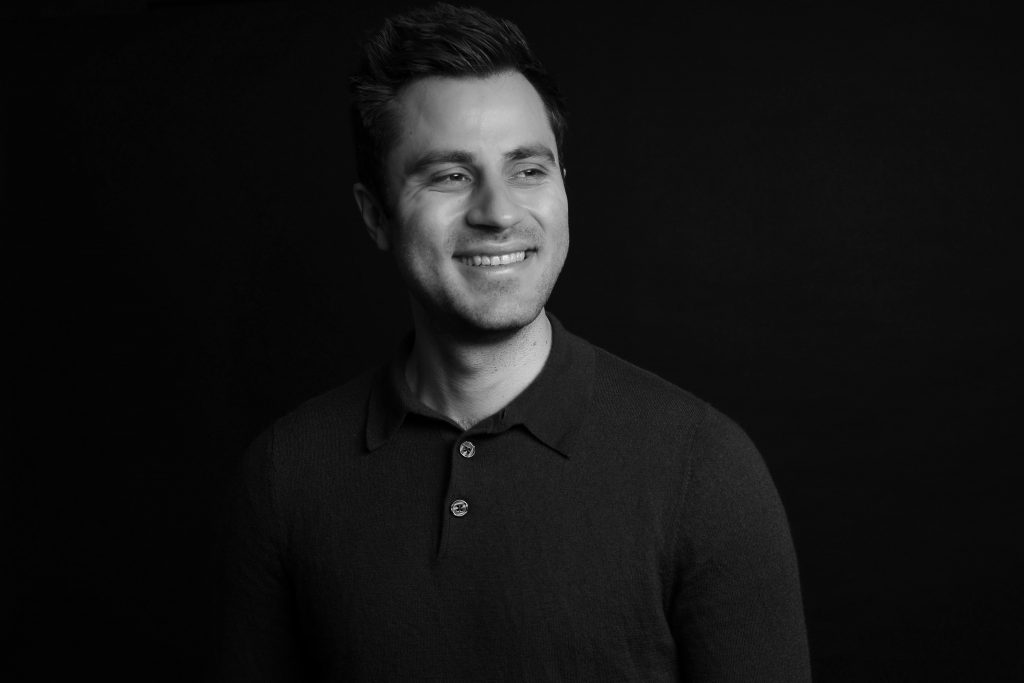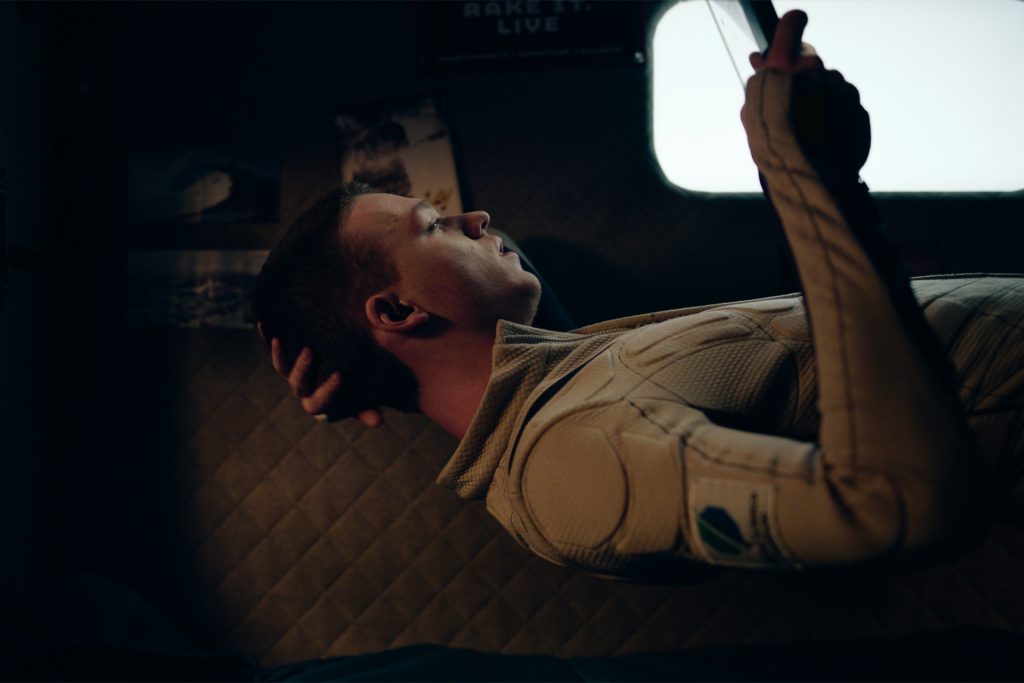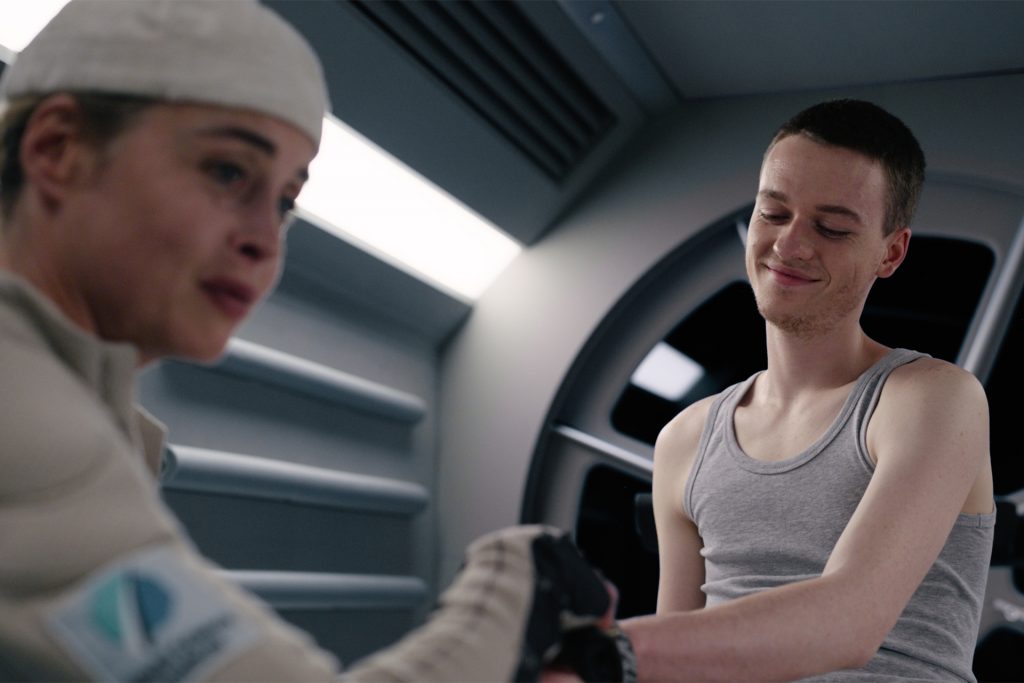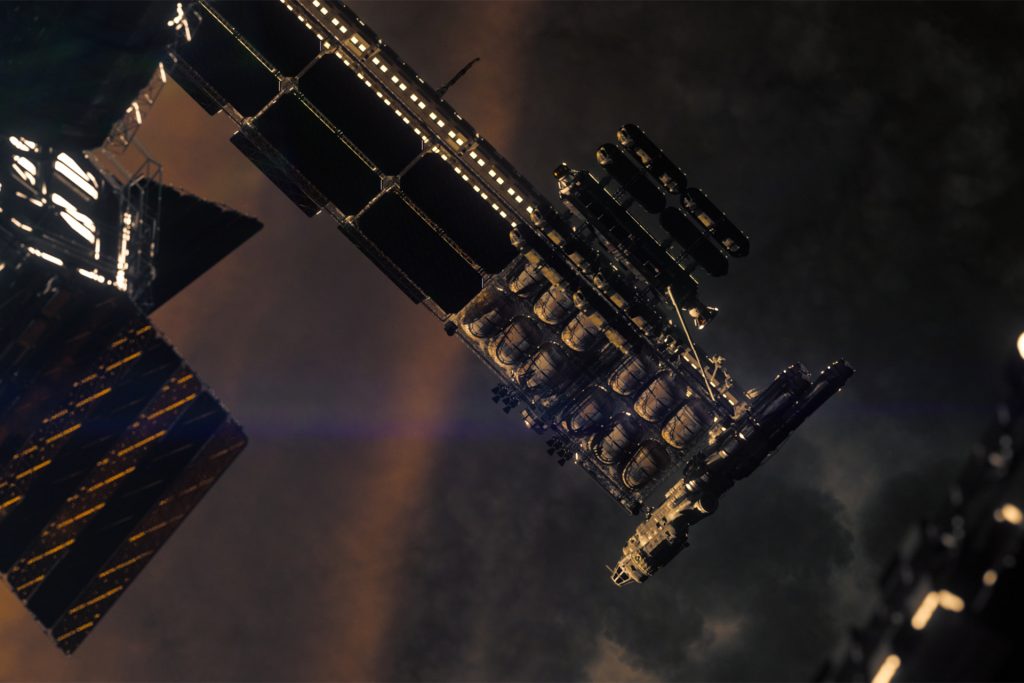Filmmaker 5 with Nils Keller: Almost Home

Short film Almost Home tells the coming-of-age story of Jakob, a teenage boy struggling to overcome a disability, living aboard a cramped spaceship with his mother. As the end of their two-year voyage nears, Jakob dreams of returning to Earth and life with his father and friends. But as they near Earth, they learn the place they left poses a threat to Jakob’s health. The unexpected choices facing this small family threaten to tear them apart.
A breathtaking short directed by Nils Keller, Almost Home won a student Academy® Award and was shortlisted for the 2023 Oscars®. Our Classic Couple interview with filmmaker Nils Keller follows.
Filmmaker 5.1: This is a coming-of-age story, a family drama, a pandemic tale, an outer space fantasy, and an exploration of disability. What was your biggest challenge in weaving these thematic threads together in the film?

Although it’s rather atypical for a short film, there are definitely various themes that we touched on. The idea was to intertwine them as the basis for a believable and heartfelt coming-of-age drama set in space. One of the reasons was that we felt it necessary to breathe some soul into this otherwise cold and hostile environment. However, a big challenge was to incorporate it naturally and not spend too much time explaining everything. Otherwise, there would have been no room left for the drama, the journey of our characters and their conflict. Especially with the disability, however, it was also imperative not to use it as a gimmick, but to portray it as an integral part of Jakob. As for the pandemic on the other hand, it was important not to give it too much space, as it is more of a cipher for the many unforeseen events that can turn our lives upside down (of course, the nature of this event is very familiar to the audience). The trick that made it possible to include all these elements in our short film was that they are so closely interwoven with the drama of our characters that they tend not to appear as independent themes, but are perceived as such only in retrospect.
Filmmaker 5.2: This is your second film collaboration with Max Richert as a writing team. How would you describe your approach to collaboration in telling a story on film?
Max is not only a great writer and director himself, he is also one of my oldest and best friends. For example, he just officiated my wife and me at our wedding. We met in school at the age of 13, started making films together and have always helped each other as producers, giving feedback, sitting in the editing room, etc. While Max wrote the script alone on my previous short film Midnight Regulations, I started to write on Almost Home alone and brought him on board after the first draft. I especially value his work on dialogue, characters and keeping things short and sweet. He was also a great help when it came to consulting in the editing process.
I really love and appreciate the collaboration part in filmmaking. I believe it unlocks the potential for great art and stories. Filmmaking indeed is a team sport!
Even though writing is a lot of fun, I wouldn’t call myself a writer in my primary capacity. I usually look for co-writers at some stage or even try to get a head writer on board after I figure out the vision for a project and then move myself into the role of a co-writer. Of course, that mainly applies to scripts based on my own ideas or where I’m involved very early on. There have been and continue to be more and more projects where I’m primarily the director – working with a great writer’s script and only doing the final fixes towards a director’s draft.


Filmmaker 5.3: Almost Home relies on a small cast. How did you find your actors and what was your directorial approach to bring forward their performances?
I’m very grateful to our actors for their trust and commitment to this no-budget project, that involved so many young filmmakers. Through their artistic love and work in preparing and playing their characters, they managed to fill this distant and abstract environment with life.
A big part of the directorial approach was to thoroughly talk through every aspect of the story and the world we were building. This included seemingly benign things like how a toilet works in space, the effects of zero gravity on the body, the hours of daily training to combat it, and so on. But in fact, it felt like clarifying these things was a crucial step in getting closer to feeling a kind of reality and day-to-day life aboard a spacecraft that’s rather abstract. Especially if it’s a film-set with movable ceilings, blue-screen, fake-closets. It didn’t seem possible for us to talk about the deeper emotional implications and feelings of our story if we didn’t have a basic understanding about what life might feel like inside this iron prison.
The next step was to make sure we found certain rituals between the two actors. A way to live with each other, but also to protect their individuality. A way to interact and talk with each other after being “trapped” in space for two years. This also influenced the final drafts. Like refining the word game the two main actors are playing twice in the film. It was influenced and changed by the actors’ ideas and made the thing more personal. I still have to meet the audience member that fully understands the rules of the game. But there are rules that make sense, I promise!
And then there was the goal that despite all the technical things, like wiring the actors for zero gravity, holograms, we wanted to make sure that the actors got as much freedom as possible to play. For that reason we kept the hologram rather low-tech, guaranteeing that all three actors could stand in the same room. Still, sometimes the direction couldn’t be as playful as I usually like because of the cramped environment, blue screens, or lack of objects to play with. After all, it’s only a 70 square meter stage.
Susanne Wolff is a well-established actress in Germany, known for her work in theater, film and television. For example she did films with German Oscar winner Volker Schlöndorff.
The most interesting reference however was her role in STYX, for which she received the GERMAN FILM AWARD. In it, she plays a woman who sails alone across the Atlantic until her tiny ship collides with a refugee boat and an escalating, morally ambiguous conflict ensues. For our role of Nico, I was looking for a complex and tough character who was able to play with rigor, but who also has these emotional breaking points. Nico is not only a mother who cares for her son, but also a scientist and a very hands-on person who can physically and mentally operate a spaceship under life-threatening conditions. Very different from a teenager with lofty dreams, emotional and social aspirations. For me, this different outlook on life was the basis for the conflict between the two.
For the role of Jakob, my aim was to find a young actor who could display extreme resilience but also vulnerability, enthusiasm and despair, thoughtfulness and emotionality. Jeremias Meyer is one of those great newcomers who are open to radically trying things and reflecting on experiences. In our case he was oftentimes asking for impulses to get things right and develop a deeper understanding of his character inside this unique situation of being trapped in space. One day he locked himself in a room to learn how to mimic zero gravity, then sent me fun videos to give him feedback on. You could really see the progress between Take 1 and 36. We were lucky enough to meet Jeremias just before his recent big career moves as an aspiring actor, working as a lead in big-budget projects for Prime Video.
Stephan Kampwirth, who plays Jakob’s father and is only present through a hologram, is a well-known actor in Germany who stars in the Netflix series DARK. I was looking for a character who, unlike Nico, is more of an emotional and warm person. His presence, his view of the situation and his influence on Jakob had to be strongly felt, even though he is not physically present. He mirrors Jakob’s enthusiasm and his love of life, standing up for the fact that you can’t make all decisions based solely on safety concerns and abstract numbers. He also stands up for Jakob’s right of empowerment and self-determination even though he himself doesn’t fully live up to it by sparing his son the full truth about the situation.


Filmmaker 5.4: As a science fiction story set in space, Almost Home includes amazing cinematography and special effects. How did you assemble and direct the production team to bring forward your vision?
I think a little foreword might be useful here. The main reason for setting our story in a futuristic and isolated environment was to distance it as much as possible from Covid 19. The spaceship is meant to provide a confined cinematic stage to reflect on what it means to be dependent – on our parents or other people who try to have a saying in our life choices – and how hard it can be to break away from that while not destroying the relationship. It’s that very physical yet metaphorical expression of not being able to run or hide. I wanted to focus on our characters and their dramatic conflict and see the larger implications of life in that. In the process it was a lot of planning, trial and error, improvisation and tireless work as well as believing that we as a small young team can do it.
In order to get here, I think it was very important, that Georg Nikolaus, the cinematographer, and I know each other since the beginning of film school. We did almost all our short films together and also worked on some commissioned productions for commercials and television together. There has always been a shared understanding that story and characters must come first when we think about the visual language. In the case of Almost Home, we discussed the possible layout of the spaceship early on to make sure we had the right mix of a narrative stage for our story and enough opportunity to visually approach the characters and their environment in an intimate way. It was also clear, that we didn’t want extravagant CGI or Sci-Fi overload but that everything should be there, to strengthen the conflict and drama. Further down the road, we used the 3D model of the spaceship, created by our incredible production designer Pan Patellis, to work out literally every shot, the blocking and camera movements. The spaceship was so cramped, the shooting time so short and the technical demands so advanced, that we had to exactly know where to put the camera and determine what walls and ceilings had to be disassembled for certain scenes. Yet we also often took a step back from planning and considered how to visually help express Jakob’s emotionality and his longing for Earth as it felt important to convey a human and poetic note in a cold environment like ours. Through highlighting Jakob’s personal items with their used surfaces, the presence of the Earth through moving sunlight, glimpses through the windows with the blue marble in sight etc.
As a result, there was a lot of planning together with the art department as well. We also stayed true to the idea of letting the camera playfully float in the beginning of the film where Jakob feels free and optimistic in zero-gravity. Advertently when gravity sets in, the visual language becomes as stiff as his body. In order to emphasize the relation between Jakob and his mother and their shifting understanding of each other, we discussed every angle, inch and trick possible inside a confined set like ours. It was of incredible help here, that ARRI Rental supported our work with their amazing equipment like the ALEXA Mini LF, lights and much more.
Regarding the Visual Effects, there wasn’t really a team there, just one person: Lukas Väth. He studied directing in the same class as I did. During our time at film school, Lukas began self-taught specializing in visual effects besides still doing great films as a director. When at the very beginning of the project, I asked him if he wanted to be the visual effects supervisor, I never expected him to be willing or able to do the complete supervision and almost all of the VFX post-production single-handedly. He really did everything from modelling the spaceship and space station from scratch, designing the holograms and displays, replacing the multifold blue screens and much more. And all of that – we’re talking about roughly 300 full or partial CGI shots in the film that were done and jointly discussed over the course of a full year in post-pro – happened from inside his home with two computers. The only element we outsourced was the very time-consuming wire removals for certain shots in zero-gravity. It’s hard to put into words how much I thank Lukas for all the time he invested into this project that wasn’t always easy to work on.
Filmmaker 5.5: What do you want audiences to take away from viewing Almost Home? What is your greatest “filmmaker’s wish” for this project?
My greatest wish is that it conveys something about the power of human relationships. The need and blessing to trust and believe in each other, even in difficult times. Also the necessity of sometimes going into conflict and sorting out our relationships. Yet above all, I think this film stands for the unpredictability of everyone’s life path, which rarely goes as planned.

